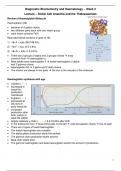Class notes
Lecture Notes Diagnostic Biochemistry and Haematology - Sickle Cell Anaemia and the Thalassaemias
- Course
- Institution
These lecture notes focus on Diagnostic Biochemistry and Hematology, particularly discussing Sickle Cell Anemia and Thalassemias. It delves into the structure of hemoglobin, the synthesis of various types of hemoglobin, and how genetic defects impact the production of normal hemoglobin chains. T...
[Show more]



